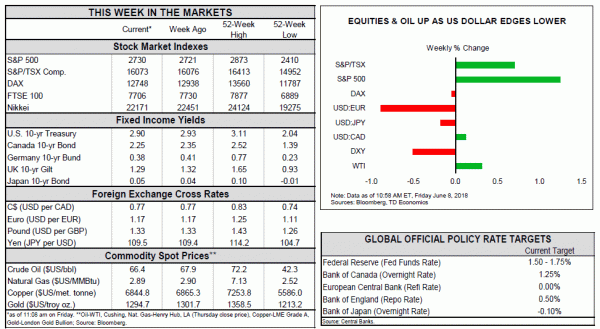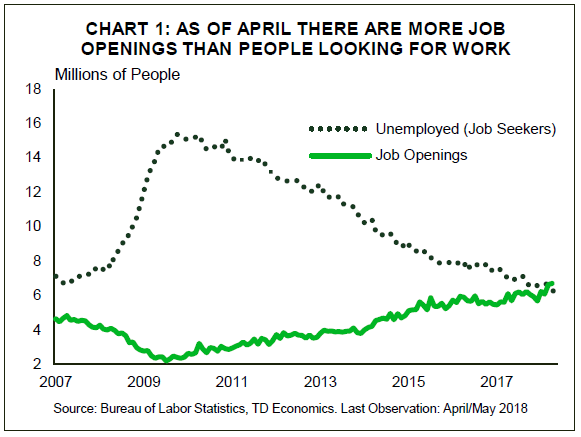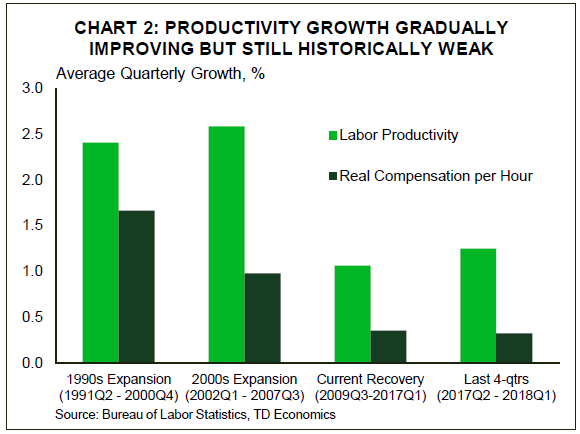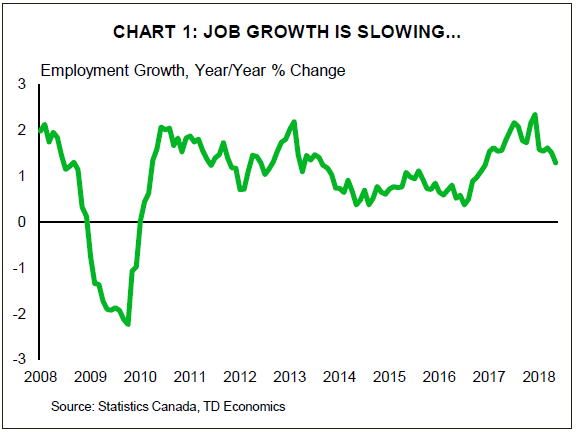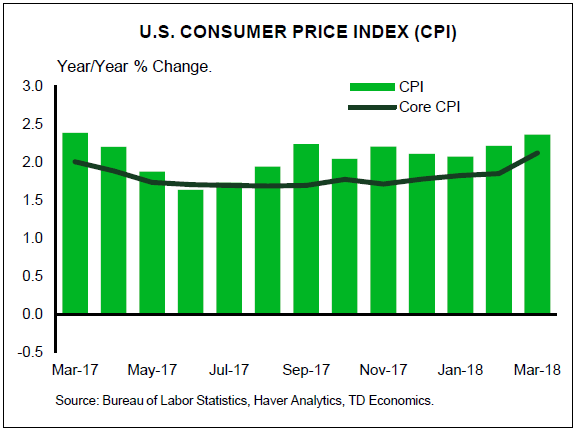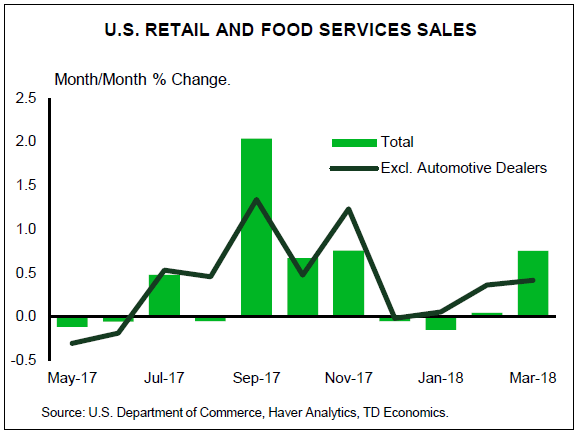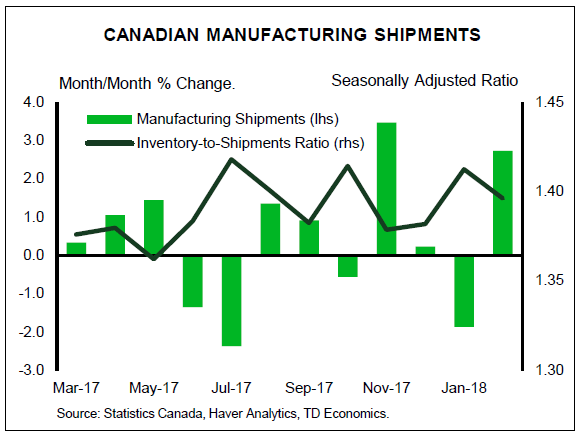U.S. Highlights
- Next week the Federal Open Market Committee (FOMC) will meet for the fourth time this year to discuss whether the current level of monetary stimulus is appropriate for the U.S. economy.
- Well above-trend economic growth and inflation at target should be enough to convince the FOMC to move its main policy rate up by 25 basis points.
- Elevated geopolitical uncertainty is likely to keep the FOMC on its current course of gradual rate hikes.
Canadian Highlights
- G7 leaders meet this weekend in Charlevoix, Quebec. Trade wars threaten to overshadow the meeting with recent U.S. tariffs on steel and aluminum sparking an escalating war of words between the U.S. and its G7 counterparts.
- Canada’s job market took a step back in May, shedding 7.5k jobs. Still, the unemployment rate remained unchanged at a cycle low of 5.8% as people left the labor market. Encouragingly, wage growth accelerated to 3.9%, its strongest reading in nine years.
- Ontario elected a new PC majority government, ending 15 years of Liberal party rule. The new government will face a challenging environment of slower economic growth and has some work ahead to maintain fiscal sustainability.
U.S. – FOMC Locked in for Second Rate Hike of 2018
Next week the Federal Open Market Committee (FOMC) will meet for the fourth time this year to discuss whether the current level of stimulus is appropriate for the U.S. economy. During their discussions they will evaluate the health of the economy, wage and price pressures, and emerging risks before deciding on revisions to their outlook for economic activity, inflation, and the future path of the fed funds rate.
The U.S. economy is firing on all cylinders at the moment. Growth in the second quarter is currently tracking a blistering 4.0% annualized pace, helped along by a strong rebound in household spending, firm business investment, and surprising strength in net exports. What’s more, growth is expected to continue at a 3.0% annualized pace on average for the remainder of the year, with fiscal stimulus contributing about half a point.
Strong economic activity is working to absorb any remaining spare capacity. The unemployment rate is at an eighteen year low, and as of April there were more job openings than there were job seekers (Chart 1). Wage growth is healthy by historical standards, but should move even higher as skilled labor becomes scarce. But, wages typically keep up with productivity growth, and on that front the U.S. economy continues to perform below historical trends (Chart 2).
Consumer price inflation is above 2.0%, a sign that the U.S. economy is bumping up against capacity constraints. Add higher fuel prices, higher import prices due to increased tariffs, and strong wage growth, and it’s just a matter of time before profit margins get pinched enough for firms to pass on rising costs to consumers. All told, headline consumer price inflation is likely to peak at 2.7% this year, with the Fed’s preferred measure, the core personal consumer expenditure deflator, holding near its target of 2.0% through the end of this year.
Altogether, this solid outlook should be more than enough to convince the FOMC that the U.S. economy does not require the amount of monetary stimulus currently on offer. As a result, the fed funds rate is likely to move up by 25 bps next week, with another hike or even two embedded in the updated dot plot summary for this year.
That said, although further rate hikes are certain, their exact timing is still open for debate. Geopolitical risks remain elevated, and a policy misstep or two may be just enough to send financial markets, business confidence, and global trade into a tailspin. Trade skirmishes could easily escalate into trade wars, particularly if talks fail to make progress between the U.S. and its major trading partners. Although much better prepared than in past tightening cycles, emerging markets remain at the mercy of nervous investors who are more concerned with capital retention than returns in such an uncertain environment. Argentina and Turkey were the first victims of speculative attacks, but they surely will not be the last during this tightening cycle. All told, in light of these and other risks, the FOMC is likely to stay on its current path of gradual rate hikes.
Canada – Trade Disputes Take Center Stage as G7 Meets
It was a whirlwind week for Canada. As Prime Minister Trudeau gets ready to host fellow G7 leaders, the trade dispute with the United States continues to boil, setting a testy stage for the meeting. Both sides appear to be steeling their resolve. On the Canadian side, Prime Minister Trudeau held a joint press conference with French President Macron, where he again expressed his dissatisfaction with steel and aluminum tariffs. Trump retorted in several tweets, calling out Canada’s protected agricultural sector.
Fortunately, there was some good news for Canada the in the international trade report this week. Canadian exports climbed 1.6% (m/m) in April, with big gains in mineral products and consumer goods. This marked the sixth increase in seven months. With imports dropping 2.5% (reversing part of the prior month’s 6% run-up), the merchandise trade deficit narrowed. This strong start to Q2 suggests that trade could add substantially to GDP growth – breaking a three-quarter streak of subtraction. Still, the external environment will remain challenging.
While exports of steel and aluminum are a small share of overall trade (accounting for 2.5% of exports and 1.5% of imports) an escalating trade war will not help. Given the headwinds to domestic demand from rising interest rates, this is one reason to expect a more muted pace of economic growth over the foreseeable future.
Were it not for the trade kerfuffle, the Canadian government had hoped to theme the meeting around inclusive economic growth and environmental sustainability. A policy paper released by the Canadian government noted that even as G7 economies have made considerable progress in moving toward full-employment, many people still feel left behind. This is important context to the meeting, and even frames the anxiety around trade. Economic growth doesn’t mean as much if the benefits only accrue to a select few. On that front, the report noted the challenges in measuring well-being that cannot be captured in GDP growth, especially in an environment of increasing inequality.
On the employment and income front, Canada’s job market took a step back for a second straight month in May, shedding 7.5k jobs. Despite the losses, the unemployment remained unchanged at a cycle-low of 5.8%. While much of the details of the report were soft (full-time jobs dropped 31k, while part time rose 23.6k), the one exception was wage growth, which accelerated to 3.9% in the month – its highest rate in nine years. Notably, wage growth has accelerated across major industries, with 12 of 16 above the 3% mark.
Of course, the other big news this week was that Ontario elected a new PC majority government, ending 15 years of Liberal party rule. The election result was not surprising, but the magnitude of the victory perhaps was. The new government will face a challenging environment. Growth in Ontario is likely to cool from its relatively heady pace over the last few years, and the government still has work to do in closing the budget deficit. The party’s pledges during the election committed to cutting taxes, but were light on details about where offsetting cuts would be made. We look forward to seeing the details as the government is formed and communicates its fiscal plans.
U.S.: Upcoming Key Economic Releases
U.S. Consumer Price Index – May
Release Date: June 12, 2018
Previous Result: 0.2% m/m, 2.5% y/y
TD Forecast: 0.3% m/m, 2.8%
Consensus: 0.2% m/m, 2.8% y/y
We expect headline CPI inflation to hit 2.8% y/y in May, led by another surge in gasoline prices. Prices at the pump jumped further by about 6%, peaking in late May. Their rise is likely to resume in the summer months, though likely by a smaller margin. Utility costs however should offset on weakness in electricity. Moderate gains in food prices will allow for a positive contribution to the headline. Outside of food and energy, we look for a 0.2% m/m print after the disappointing 0.1% print in the prior month. That should drive core inflation higher to 2.2% y/y. Driving the pickup will be a firmer read on core goods prices after back-to-back declines in the prior month and ongoing strength in core services, the latter led by potential pickups in medical care and airfares. However, we expect any rebound to be limited by a likely moderation in OER and rents, which posted outsized gains in April. Thus, we view risks as skewed to the downside.
U.S. Retail Sales – May
Release Date: June 14, 2018
Previous Result: 0.3%, ex-auto 0.3%
TD Forecast: 0.5%, ex-auto 0.7%
Consensus: 0.4%, ex-auto 0.5%
We look for a strong 0.5% rise in retail sales, propped up by higher gasoline prices along with a solid 0.3% increase in the core group. More favorable weather suggests a boost from building materials and food services categories as well. This should leave Q2 real consumer spending tracking near a robust 3% pace given the solid performance in April.
Canada: Upcoming Key Economic Releases
Canadian Manufacturing Sales – April
Release Date: June 15, 2018
Previous Result: 1.4% m/m
TD Forecast: 1.0% m/m
Consensus: N/A
TD expects manufacturing sales to rise by 1.0% m/m in April, building on strength in the prior two months. Non-durable goods should serve as the primary driver of growth amid a sharp pickup in gasoline prices, while soft exports of transportation equipment suggest a weaker performance in durables. The advance in real manufacturing sales should be roughly half the nominal gain owing to higher factory prices, though this is still suggestive of a healthy contribution to industry-level GDP for April. Looking ahead, Canada’s manufacturing sector is subject to elevated uncertainty following the implementation of steel and aluminum tariffs, which took effect on June 1st, though the strong hand-off from March should help to anchor Q2 exports.




